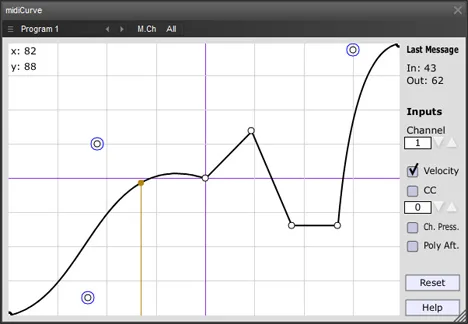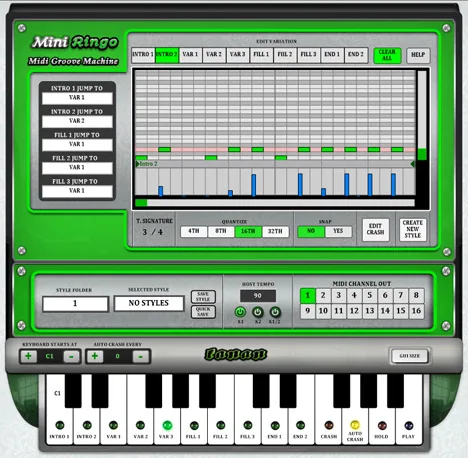midiCurve: Your Precise Control Over MIDI Expression
In the world of electronic music and MIDI control, expressiveness is key. How you touch the keys, press the pedals, or use controllers can drastically change the emotional impact and dynamics of your work. The midiCurve plugin from Insert Piz Here is a powerful tool designed to give you unprecedented control over your MIDI expression. Forget about linear or standard response – now you can shape your MIDI messages the way your musical idea demands.
What is a MIDI Curve and Why Do You Need It?
Traditionally, MIDI controllers send data (such as key velocity or modulation wheel position) in a linear way. This means that a 10% change in the controller’s position results in a 10% change in the corresponding sound parameter (e.g., volume or filter cutoff frequency). However, musical expression is often not linear. For example, you might want quiet key presses to have very subtle differences, while stronger presses would give a more dramatic jump in dynamics. Or you may want the modulation wheel to affect a parameter only after reaching a certain threshold.
This is where the concept of MIDI curves comes in handy. A MIDI curve is a graphical representation of how an incoming MIDI value (e.g., raw velocity data) is converted into an outgoing value. Instead of a straight line, you can use curves of different shapes: exponential, logarithmic, S-shaped, etc. Each curve shape creates a unique relationship between your physical movement and the sound response, allowing you to fine-tune the sensitivity and range of control.
midiCurve: A Master of Shaping MIDI Data
midiCurve specializes in applying such curves to the most important types of MIDI messages used for expressiveness:
- Velocity: Determines how hard you press a key. Usually affects the volume and/or timbre of the instrument. With midiCurve, you can make the instrument more sensitive to light touches or, conversely, smooth out the dynamics to avoid sudden volume jumps.
- Aftertouch: The pressure you apply to a key *after* it is pressed. Often used to add vibrato, change pitch, control the filter, or other effects while holding a note. midiCurve allows you to adjust how much Aftertouch affects these parameters and how quickly the changes will occur.
- Channel Pressure: Similar to Aftertouch, but applies to all keys held on a specific MIDI channel simultaneously. This is useful when you want to apply an effect (e.g., chorus or reverb) to a whole chord by changing the pressure with one hand. midiCurve enables you to shape the response to Channel Pressure just as accurately.
- Control Change (CC): The most versatile type of MIDI messages, used to control a wide range of parameters: modulation and pitch wheels, expression pedals, synthesizer knob positions (filter, resonance, envelopes), etc. Thanks to midiCurve, you can reassign or change the reaction of any CC message, creating unexpected or more intuitive links between your controller and the sound.
The plugin provides a visual curve editor where you can easily draw or modify the shape of the relationship between incoming and outgoing MIDI values for each of these message types.
Features and Workflow
midiCurve is designed with ease of use in music production and live performances in mind:
- 128 Presets: Store up to 128 different curve configurations. This allows you to have sets of settings for different instruments, songs, or playing styles, quickly switching between them.
- MIDI Program Change Support: The ability to switch presets using MIDI Program Change messages makes integrating midiCurve into your workflow even more convenient. You can automate the curve changes directly from your sequencer or MIDI controller during a performance.
- Intuitive Interface: Although the plugin offers deep customization, its interface is designed to be clear. Detailed instructions are available directly in the plugin (just click “Help”).
Using midiCurve as a VST plugin in your DAW (e.g., FL Studio, Ableton Live, Cubase on Windows) opens the door to a new level of control. You can insert it into the MIDI chain before the virtual instrument or another MIDI plugin to modify the data in real time.
Technical Details
Developed by Insert Piz Here, midiCurve is available in VST format for Windows operating systems (Win32). This ensures compatibility with the vast majority of popular DAWs on this platform.
Conclusion
If you want to maximize the potential of your MIDI controllers and virtual instruments, if you want to add unique expressiveness to your music and gain full control over dynamics and modulation, midiCurve from Insert Piz Here is a tool worth having in your arsenal. It transforms standard MIDI data into a personalized and highly expressive stream of information, opening new horizons for your creativity. Try midiCurve and feel the difference in your musical performances and arrangements.



